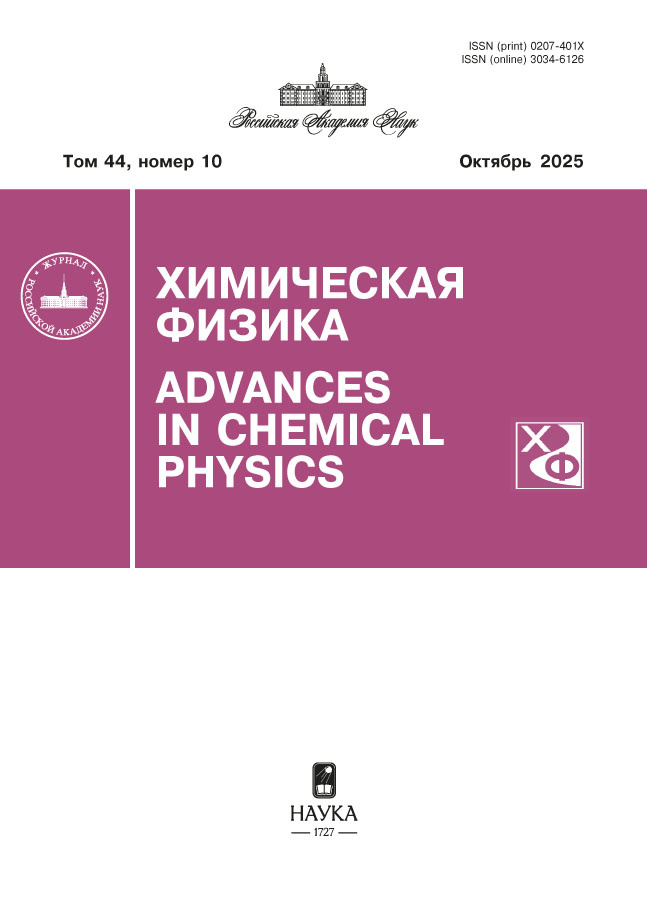Detonation characteristics of finely dispersed ammonium perchlorate
- 作者: Ermolaev B.S.1, Gavrushova V.D.1, Basakina S.S.1, Komissarov V.P.1
-
隶属关系:
- Semenov Federal Research Center of Chemical Physics
- 期: 卷 44, 编号 10 (2025)
- 页面: 46-58
- 栏目: Combustion, explosion and shock waves
- URL: https://edgccjournal.org/0207-401X/article/view/692377
- DOI: https://doi.org/10.7868/S3034612625100054
- ID: 692377
如何引用文章
详细
Using a quasi-one-dimensional model of steady detonation with a divergent flow in the reaction zone, an analysis of an array of experimental data on the detonation rate of finely dispersed ammonium perchlorate was carried out, which was obtained at one time by Donna Price with her colleagues from the NOL Laboratory of the USA. In these experiments, the diameter and initial charge density varied over a wide range. As a result of the analysis, the values of two coefficients included in the equation of the rate of exothermic conversion of AP (the pressure exponent n and the rate constant G) were determined, at which the calculations are consistent with the experiment on the dependence of the detonation velocity on the charge diameter for five different values of initial density. In all calculations, the exponent of n turned out to be 1.0, and the constant G decreased by more than 4 times, as the initial density increased from 1.0 to 1.45 g/cm3. The flow characteristics in the detonation wave reaction zone were calculated. The detonation wave front has a shape close to spherically symmetrical, only on and near the charge axis. The radius of curvature of the front, which is close in magnitude to the diameter of the charge on the charge axis, decreases 4–5 times as it approaches the side interface of the charge. Along with the radius of curvature near the side interface, the pressure at the wave front decreases significantly. The width of the reaction zone, from the wave front to the Chapman-Jouget point, is about 3 mm and increases with increasing density. An analysis of the calculated characteristics of the reaction zone for near-critical conditions close to detonation failure showed that a significant decrease in the particle velocity gradient at the wave front due to energy losses in the lateral rarefaction wave is observed at the side interface of the charge and is absent on the charge axis. Thus, it is the side interface of the charge that should be considered as the place whereconditions for detonation failure are formed, as a result of a decrease in the rate of exothermic conversion and an increase in energy losses in the lateral rarefaction wave.
作者简介
B. Ermolaev
Semenov Federal Research Center of Chemical Physics
Email: boris.ermolaev44@mail.ru
Moscow, Russia
V. Gavrushova
Semenov Federal Research Center of Chemical PhysicsMoscow, Russia
S. Basakina
Semenov Federal Research Center of Chemical PhysicsMoscow, Russia
V. Komissarov
Semenov Federal Research Center of Chemical PhysicsMoscow, Russia
参考
- Andersen W.H., Pesante R.E. // Proc. 8th Sympos. (Int.) on Combustion. Williams and Wilkins Co. Baltimore, Md., 1965. P. 705.
- Price D., Clairmont A.R., Jr., Jaffe I. // Combustion and Flame. 1967. V. 11. Issue 5. P. 415.
- Price D., Clairmont A.R., Jr., Erkman J.O. // Ibid. 1973. V. 20. Issue 3. P. 389.
- Ermolaev B.S., Khasainov B.A., Presles N., Vidal P. // Proc. Second European Combustion Meeting, ECM. Louvain-la-Neuve, Belgium, CD ROM: ECM-2005.
- Ermolaev B.S., Khasainov B.A., Presles H.N. // Proc. 34th Intern. Pyrotech. Seminar “EUROPYRO 2007”. V. 1. Broune, France: AFPYRO, 2007. P. 323.
- Ермолаев Б.С., Комиссаров П.В., Соколов Г.Н., Борисов А.А. // Хим. физика. 2012. Т.31. № 9. C. 55.
- Ермолаев Б.С., Сулимов А.А. Конвективное горение и низкоскоростная детонация пористых энергетических материалов. М.: Торус Пресс, 2017.
- Ермолаев Б.С., Шевченко А.А, Долгобородов А.Ю., Маклашова И.В. // Хим. физика. 2019. Т. 38. № 2. С. 52.
- Ермолаев Б.С., Комиссаров П.В., Басакина С.С., Лавров В.В. // Хим. физика. 2023. Т. 42. № 9. C.63.
- Ермолаев Б.С., Комиссаров П.В., Басакина С.С., Лавров В.В. // Хим. физика. 2024. Т. 43 № 3. С. 87. https://doi.org/10.31857/S0207401X24030096
- Викторов С.Б., Губин С.А., Маклашова И.В. и др. //Хим. физика. 2005. Т. 24. № 12. С. 22.
- Смирнов Е.Б., Аверин А.Н., Лобойко Б.Г. // Физика горения и взрыва. 2012. Т. 48. № 3. С. 69.
- Swift D.C., Lambourn B.D. // Proc. 10th Int. Deton.Sympos. Boston. Ma. ONR 33395-12. 1993. P. 386.
- Bdzil J., Stewart D.S. // Phys. Fluids A.1989. V. 1. P. 1261.
- Dobratz D.M., Crawford P.C. LLNL Explosive Handbook. Properties of Chemical Explosives and Explosive Simulants.Livermore: LLNL Laboratory, 1985. Rep. UCRL-52997.
- Зельдович Я.Б., Компанеец А.С. Теория детонации. М.: Гостехиздат, 1955.
- Stewart D.S., Bdzil J.B. // Combust. and Flame. 1988. V. 72. P. 311.
- Кобылкин И.Ф., Соловьев В.С., Бойко М.М. // Физика горения и взрыва. 1983. Т. 19. № 4. С. 120.
补充文件









